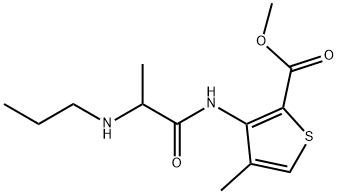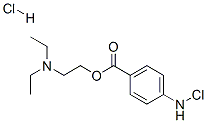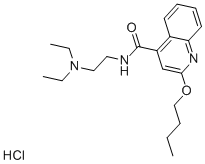Oxybuprocaine
- CAS NO.:99-43-4
- Empirical Formula: C17H28N2O3
- Molecular Weight: 308.42
- MDL number: MFCD00242863
- SAFETY DATA SHEET (SDS)
- Update Date: 2023-12-15 17:16:12

What is Oxybuprocaine?
Originator
Dorsacaine HCl,Dorsey,US,1953
The Uses of Oxybuprocaine
Anesthetic (topical).
Background
Oxybuprocaine (also known as Benoxinate) is a local anesthetic, which is used especially in ophthalmology and otolaryngology. Oxybuprocaine binds to sodium channels and reversibly stabilizes the neuronal membrane which decreases its permeability to sodium ions.
Indications
Used to temporarily numb the front surface of the eye so that the eye pressure can be measured or a foreign body removed.
Definition
ChEBI: A benzoate ester in which 4-amino-3-butoxybenzoic acid and 2-(diethylamino)ethanol have combined to form the ester bond; an ester-based local anaesthetic (ester "caine") used especially in ophthalmology and otolaryngology.
Manufacturing Process
25 grams of 3-oxy-4-nitrobenzoic acid are esterified (ethyl ester) and 26
grams of the ester are dissolved in 200 cc of absolute ether and treated with
7 grams of caustic potash in 20 cc of absolute methanol. The red potassium
phenolate with 7 grams of pure butyl bromide and 7 grams of absolute alcohol
are heated for 5 hours in the oven to 150°C. When cool, the alcohol is
evaporated in vacuo and the butoxy-nitrobenzoic acid ethyl ester is
precipitated with water. The substance is sucked off and saponified for 15
minutes with a solution of 2.5 grams of caustic potash in 30 cc of alcohol on a
water bath. The alcohol is evaporated in vacuo and the 3-butoxy-4-
nitrobenzoic acid is precipitated with hydrochloric acid. It forms needles which
melt at 174°C. 7.9 grams of dry acid are boiled for 45 minutes under a reflux
condenser with 25 cc of thionyl chloride. The excess of thionyl chloride is then
removed in vacuo, and the oil is distilled. The acid chloride has a yellow color
and solidifies.
7.3 grams of the acid chloride are treated with 6.6 grams of diethyl-aminoethanol
in 20 cc of absolute benzene. The mixture is then warmed for 1 hour
on a water bath. When cold, it is treated with a solution of soda and washed
with ether. After drying over potash, the ether and benzene are removed by
distillation and 3-butoxy-4-nitrobenzoic acid diethylamino-ethyl ester is
obtained, having a BP 215°C/2.5 mm.
5.0 grams of this product are hydrogenated in absolute alcohol solution with
fresh Raney nickel. When the absorption of hydrogen ceases (5 hours), the
solution is filtered and the alcohol evaporated in vacuo. The 3-butoxy-4-
aminobenzoic acid diethyl-amino-ethyl ester boils at 215°-218°C at 2 mm
pressure; it is an almost colorless oil.
By precipitation of a solution of the ester in absolute ether with hydrogen
chloride gas, the dihydrochloride is obtained; upon recrystallization from
alcohol/ether, it forms crystals which melt at 196°-197°C.
brand name
Dorsacaine (Novartis).
Therapeutic Function
Local anesthetic
Pharmacokinetics
Oxybuprocaine is a local anaesthetic. It may be less irritating than tetracaine, and the onset and duration of action are similar to tetracaine.
Metabolism
Not Available
Properties of Oxybuprocaine
| Boiling point: | bp2 215-218° |
| Density | 1.052±0.06 g/cm3(Predicted) |
| storage temp. | Keep in dark place,Sealed in dry,Room Temperature |
| solubility | Methanol (Slightly) |
| pka | 9.16±0.25(Predicted) |
| form | Oil |
| color | Clear Pale Yellow |
| NIST Chemistry Reference | Benoxinate(99-43-4) |
Safety information for Oxybuprocaine
| Signal word | Warning |
| Pictogram(s) |
 Exclamation Mark Irritant GHS07 |
| GHS Hazard Statements |
H302:Acute toxicity,oral H315:Skin corrosion/irritation H319:Serious eye damage/eye irritation H335:Specific target organ toxicity, single exposure;Respiratory tract irritation |
| Precautionary Statement Codes |
P261:Avoid breathing dust/fume/gas/mist/vapours/spray. P280:Wear protective gloves/protective clothing/eye protection/face protection. P301+P312:IF SWALLOWED: call a POISON CENTER or doctor/physician IF you feel unwell. P302+P352:IF ON SKIN: wash with plenty of soap and water. P305+P351+P338:IF IN EYES: Rinse cautiously with water for several minutes. Remove contact lenses, if present and easy to do. Continuerinsing. |
Computed Descriptors for Oxybuprocaine
Oxybuprocaine manufacturer
New Products
(S)-3-Aminobutanenitrile hydrochloride 4-Methylphenylacetic acid N-Boc-D-alaninol N-BOC-D/L-ALANINOL Tert-butyl bis(2-chloroethyl)carbamate 3-Morpholino-1-(4-nitrophenyl)-5,6-dihydropyridin- 2(1H)-one Furan-2,5-Dicarboxylic Acid Tropic acid 1-Bromo-3,5-Di-Tert-Butylbenzene S-2-CHLORO PROPIONIC ACID ETHYL ISOCYANOACETATE 2-Bromo-1,3-Bis(Dimethylamino)Trimethinium Hexafluorophosphate 4-IODO BENZOIC ACID 3-NITRO-2-METHYL ANILINE 1-(2,4-DICHLOROPHENYL) ETHANAMINE (2-Hydroxyphenyl)acetonitrile 4-Bromopyrazole 2-(Cyanocyclohexyl)acetic acid 4-methoxy-3,5-dinitropyridine 1-(4-(aminomethyl)benzyl)urea hydrochloride 2-aminopropyl benzoate hydrochloride diethyl 2-(2-((tertbutoxycarbonyl)amino) ethyl)malonate tert-butyl 4- (ureidomethyl)benzylcarbamate Ethyl-2-chloro((4-methoxyphenyl)hydrazono)acetateRelated products of tetrahydrofuran



![4-AMINO-N-[2-(DIETHYLAMINO)ETHYL]BENZAMIDE](https://img.chemicalbook.in/StructureFile/ChemBookStructure1/GIF/CB1211904.gif)




You may like
-
 99-43-4 Benoxinate 99%View Details
99-43-4 Benoxinate 99%View Details
99-43-4 -
 2033-24-1 98%View Details
2033-24-1 98%View Details
2033-24-1 -
 1975-50-4 98%View Details
1975-50-4 98%View Details
1975-50-4 -
 2-HYDROXY BENZYL ALCOHOL 98%View Details
2-HYDROXY BENZYL ALCOHOL 98%View Details
90-01-7 -
 2-Chloro-1,3-Bis(Dimethylamino)Trimethinium Hexafluorophosphate 221615-75-4 98%View Details
2-Chloro-1,3-Bis(Dimethylamino)Trimethinium Hexafluorophosphate 221615-75-4 98%View Details
221615-75-4 -
 61397-56-6 CIS BROMO BENZOATE 98%View Details
61397-56-6 CIS BROMO BENZOATE 98%View Details
61397-56-6 -
 14714-50-2 (2-Hydroxyphenyl)acetonitrile 98+View Details
14714-50-2 (2-Hydroxyphenyl)acetonitrile 98+View Details
14714-50-2 -
 118753-70-1 98+View Details
118753-70-1 98+View Details
118753-70-1